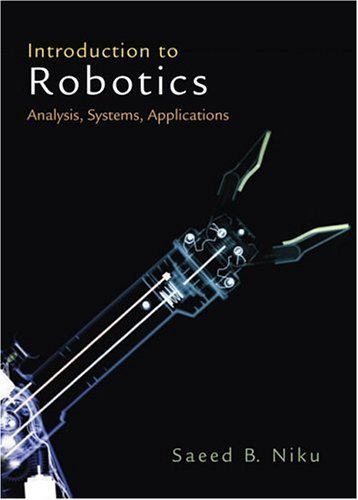
Synopsis
This books serves as an introduction to robotics analysis, the systems and sub-systems that constitute robots and robotic systems, and robotics applications. All of the fundamentals of robotics are covered—robotics analysis; including kinematics, kinetics and force control, and trajectory planning of robots; its sub-systems such as actuators, sensors, and vision systems; as well as robotics applications. Introduction to Robotics also includes many subjects related to mechatronics, microprocessor actuator control, integration of sensors, vision systems, and fuzzy logic. For practicing mechanical engineers, electronic and electric engineers, computer engineers, and engineering technologists who would like to learn about robotics.
"synopsis" may belong to another edition of this title.
From the Back Cover
This book offers comprehensive, yet concise coverage of robotics. It covers analysis of robot kinematics, differential motions, robot dynamics, and trajectory planning. It then proceeds to discuss in detail such important robot subsystems as actuators, sensors, vision systems, and fuzzy logic (at an introductory level). Robotic applications are drawn from a wide variety of fields.
Features:
- Provides comprehensive coverage of kinematics and dynamics of robotics, plus coverage of important subsystems.
- Includes microprocessor and mechatronic robotics applications, as well as an entire chapter on vision systems (image processing and image analysis).
- Applications oriented with design projects, examples, and homework problems.
- Introduces a running design project at the end of Chapter 2. At the end of each subsequent chapter, the reader is asked to apply the, concepts learned to the running design example. The intended result is that by the end of the book the reader has designed a complete robot.
The book is intended for senior or first-year graduate courses in robotics. It is also an excellent resource for practicing engineers to aid their development and design work in robotics.
"About this title" may belong to another edition of this title.
Other Popular Editions of the Same Title
Search results for Introduction to Robotics: Analysis, Systems, Applications
INTRODUCTION TO ROBOTICS ANALYSIS, SYSTEMS, APPLICATIONS
Seller: Cape Cod Booksellers, Yarmouth, MA, U.S.A.
Hard Cover. Condition: Very Good+. No Jacket. First Edition. Prentice Hall Press, 2001, First Edition, 4to, 349 pages, illustrations. Hardcover edition, no dust jacket as issued. Book in very good+ condition. Size: 4to - over 9¾" - 12" Tall. Seller Inventory # GD011097WRBC6S2
Introduction to Robotics: Analysis, Systems, Applications
Seller: World of Books (was SecondSale), Montgomery, IL, U.S.A.
Condition: Good. Item in good condition. Textbooks may not include supplemental items i.e. CDs, access codes etc. Seller Inventory # 00096447165
Introduction to Robotics: Analysis, Systems, Applications
Seller: ThriftBooks-Dallas, Dallas, TX, U.S.A.
Hardcover. Condition: Very Good. No Jacket. Former library book; May have limited writing in cover pages. Pages are unmarked. ~ ThriftBooks: Read More, Spend Less. Seller Inventory # G0130613096I4N10
Introduction to Robotics: Analysis, Systems, Applications
Seller: Goodwill Industries of VSB, Oxnard, CA, U.S.A.
Condition: Acceptable. The book is 100% readable but visibly worn, and damaged. This may include stains, tears, rips, folded pages, binding damage, dents, scuffs, scratches and sticker residue. The book also may contain heavy highlighting and notes. Please ask for photos as our books are donations and may not contain above mentioned defects. Seller Inventory # 4JQZV10007ZI
Introduction to Robotics: Analysis, Systems, Applications
Seller: Saint Georges English Bookshop, Berlin, Germany
Hardcover. Condition: Very Good. Excellent condition Hardcover, Printed boards, no dust jacket presumably as supplied, Unmarked text. Ships from Berlin Bookshop bxn81. Seller Inventory # 10004915
Buy Used
Ships from Germany to U.S.A.
Quantity: 1 available
Introduction to Robotics: Analysis, Systems, Applications
Seller: bmyguest books, Toronto, ON, Canada
Hardcover. Condition: Very Good. No Remarks Or Highlights Inside. Hardcover, In Very Good Condition. 349 Pages With The Index.books are NOT signed. We will state signed at the description section. we confirm they are signed via email or stated in the description box. - Specializing in academic, collectiblle and historically significant, providing the utmost quality and customer service satisfaction. For any questions feel free to email us. Seller Inventory # 044057
Buy Used
Ships from Canada to U.S.A.
Quantity: 1 available
Introduction to Robotics: Analysis, Systems, Applications
Seller: Toscana Books, AUSTIN, TX, U.S.A.
Hardcover. Condition: new. Excellent Condition.Excels in customer satisfaction, prompt replies, and quality checks. Seller Inventory # Scanned0130613096
Introduction to Robotics: Analysis, Systems, Applications
Seller: Books-Evermore, College Station, TX, U.S.A.
Hardcover. Condition: As New. Dust Jacket Condition: New. 1st Edition. New hardcover First Edition, 2001. Seller Inventory # 000036
Introduction to Robotics: Analysis, Systems, Applications
Seller: BennettBooksLtd, San Diego, NV, U.S.A.
hardcover. Condition: New. In shrink wrap. Looks like an interesting title! Seller Inventory # Q-0130613096

